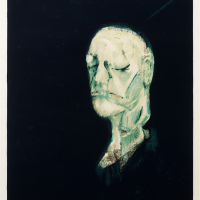08. FRANCIS BACON

Francis Bacon was, in many ways, the British painter of the post-war era. His images of the human form are unrivalled in the directness of their approach and the finesse of their execution. In distorting the human figure almost beyond recognition, Bacon sought to achieve an abject verisimilitude: My paintings are not illustrations of reality but a concentration of reality and a shorthand of sensation.1
Unlike his close friend and protg Brett Whiteley, Bacon came to printmaking late in his career. During the mid-1970s, Bacon embarked on a period of close collaboration with the French copperplate engraver Georges Visat, creating a series of etchings to illustrate the published essays of art historian Eddy Batache.2 From the early 1980s until his death in 1992, Bacon produced a sequence of etchings, aquatints and lithographs that were closely derived from his earlier paintings.3 The two works presented here Masque Mortuaire de William Blake 1991 and Seated Figure 1992 are important examples of these.
Masque Mortuaire de William Blake is a faithful recreation of Bacons Study for Portrait II (after the Life Mask of William Blake), a celebrated 1955 painting now held by the Tate. Bacons eerie subject is the life mask of the Romantic artist-poet, William Blake (1757-1827), which inspired a series of five portrait studies. Bacon first encountered the mask in the National Portrait Gallery, London, and subsequently acquired a version for his studio at 7 Reece Mews.4 In Bacons rendition, the poets disembodied head floats, ghostly and expressionless, against a black ground. Blakes features appear flattened and elongated, akin to a robbers face in a stocking.5 With characteristic deftness, Bacon has applied the paint incrementally, contrasting the softened outline of the poets skull with the broad, diagonal smears that denote his cheekbone. Bacon presents an image of death in life; of a famously imaginative mind reduced to its constituent parts.
Seated Figure is a classic image, derived from Bacons 1977 painting of the same title. The artists hapless sitter is shown partly clothed in a swivel chair, his muscular physique contorted by the act of rotary motion. A sinister, bird-like form envelopes his lower limbs; at his feet lie scattered papers of unknowable content. The pictorial space is flattened and defined to create a menacing prism of line and shadow. In its frontal presentation and use of a central, crucifix-like form, the image carries the power of a religious icon though one unlikely to offer salvation. It is an image of immense visual force, undiluted by its translation into printed form.
Footnotes:
1. Francis Bacon, quoted in Bond, A., Francis Bacon: Five Decades, Art Gallery of New South Wales, Sydney, 2012, p.12
2. About: Francis Bacon: Selected Graphics, Marlborough Graphics, London, 2022 (accessed September 2022): https://www.marlboroughgraphics.com/exhibition/Francis%20Bacon%20Selected%20Graphics
3. Ibid.
4. Jones, J., Study for Portrait II after the Life Mask of William Blake, Francis Bacon (1955), The Guardian [online], 24 February 2002 (accessed September 2022): https://www.theguardian.com/culture/2002/feb/23/art.williamblake
5. Ibid.
Catherine Baxendale